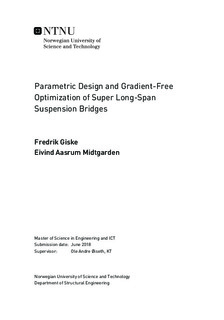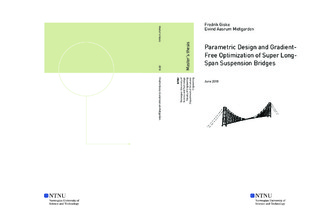| dc.description.abstract | This thesis demonstrates the feasibility of the application of using an optimizing process when designing long-span suspension bridges, using a parametric FE-model. The optimization process is tested on a proposed single span, twin-box suspension bridge of 2800m across Sulafjorden. In a case study, the parametric model is used to create an Abaqus model of a specific geometry. Multimodal flutter speed is computed for this design, where corresponding aerodynamic derivatives obtained by wind tunnel tests are used.
The objective of the optimization process is to minimize the total material cost of the structure. A gradient-free optimization algorithm is used to optimize the tower height and the girder gap, considering total material cost. Three girders with different plate thicknesses are analyzed in the optimization. The main code to perform the optimization process is written in MATLAB, which is connected to Abaqus to obtain the responses, sectional forces and modal properties.
In hand with the parametric model, the gradient-free optimization procedure provides essential information about the bridge structure, which is used to study structural behavior.
The optimizing process gives a proposed tower height of 391 meters and a girder gap of 22.6 meters, when the smallest girder is used. However, this proposal is highly dependent on the objective function, which has several uncertainties.
The case study evaluates the modifiability of the parametric model by creating a specific bridge design. The flutter speed is calculated to 67.23 m/s, which is less than the calculated criteria for flutter speed. By including flutter calculation into an optimization process and improving the objective function, the application of an optimizing process may be highly beneficial for complex bridge structures. | |

